Introduction
A Brief History of Chess
Chess on the Internet
This page is dedicated to the complex and fascinating game of chess. I have assumed that the reader already has some familiarity with the game and how it is played; you will not find here a treatment of the rules or elementary tactics. My purpose is to delve into the background of this game, and to discuss some of the resources available to chess players on the internet.
Enter any bookstore, retail or used, and you will find chess books on the shelves devoted to games. Most of these will be texts for beginning players, and books on elementary strategy and tactics. There will be many books devoted to play in the openings, and perhaps even the latest edition of MCO (Modern Chess Openings). If the section for games is large enough, there may even be copies of Aron Nimzovitch's classic My System, or Fine's work on the end game. Seldom will you find a book that deals with the complex history and development of chess.
Modern international chess as it is played today is a relatively recent invention. The sweeping moves of the queen and the long reach of the bishops were not elements of the original game. Nor were such maneuvers as castling or capturing en passant. On the other hand, the moves of the remaining pieces are nearly identical to those of their ancient analogues.
Moreover, there are other forms of chess still being played today which, while not so widespread geographically as western chess, are yet played by significant numbers of people. Indeed, the variety of chess played in China, Hong Kong, and Taiwan can claim as many, if not more, players as its western counterpart. Japan's chess, significantly different from both the western and Chinese versions, also claims players who number in the millions.
In the following paragraphs I present a brief survey of the evolution of chess as it spread east and west from India, the country of its origin. Be aware, however, that there are alternate theories regarding the origin of chess, and its development in various places. Some of them are plausibly argued, while others fail to pass the giggle test. Naturally, I'm partial to the explanations I'm presenting below. Still, caveat lector!
The extreme antiquity of chess seems to be more legendary than actual, as is the case with so many games. According to legend, the game was invented between four or five thousand years ago, by the wife of King Ravana of Ceylon, when the capital was besieged by Rama (Forbes, History of Chess, 1860). Most historians now agree that Chess originated in India, probably during the 6th century. At this time a game called Shaturanga was being played, which used pieces and moves similar to those of Shatranj (see below). There is some debate as to whether Shaturanga was the ancestor of Shatranj, or a contemporary variant. Shaturanga was apparently played on a board that was originally used for a different game altogether: a race-type game called Ashtapada (similar in general concept to Pachisi). Since a board for another game was adapted for Shaturanga, I tend to the opinion that it was the precursor of Shatranj, rather than a variant.
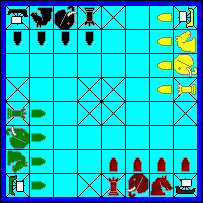 Shaturanga was played on a board of 64 squares, on which four opposing forces were arrayed, one in each corner of the board: black, red, green, and yellow. Each player had a rajah, which moves as the modern king; an elephant, with moves equivalent to the modern rook; a horse, equivalent to the modern knight; a ship (roka in Sanskrit), which could move two squares diagonally, leaping over intervening pieces; and four pawns, which could move one square forward, capturing along the diagonal. The players sitting opposite each other were loosely allied against the other two players. Each player moved in turn by rolling an oblong die, the long sides marked 2, 3, 4, and 5. The number thrown determined which piece could be moved that turn:
Shaturanga was played on a board of 64 squares, on which four opposing forces were arrayed, one in each corner of the board: black, red, green, and yellow. Each player had a rajah, which moves as the modern king; an elephant, with moves equivalent to the modern rook; a horse, equivalent to the modern knight; a ship (roka in Sanskrit), which could move two squares diagonally, leaping over intervening pieces; and four pawns, which could move one square forward, capturing along the diagonal. The players sitting opposite each other were loosely allied against the other two players. Each player moved in turn by rolling an oblong die, the long sides marked 2, 3, 4, and 5. The number thrown determined which piece could be moved that turn:
| Roll | Piece Moved | 
|
|---|---|---|
| 2 | Ship | |
| 3 | Horse | |
| 4 | Elephant | |
| 5 | Rajah or Pawn |
Shaturanga was a gambling game with complex rules, which I will not endeavor to explain here. Eventually, a variant two-player game was evolved when the allied sides were combined and the die roll was eliminated. The second rajah was made a prime minister, and its movement reduced to one square along the diagonal. The moves of the elephant and the ship were transposed. In India the game continued to be called Shaturanga by speakers of Hindu languages, while Arabic and Persian speakers called it Shatranj.
The earliest mention we have in ancient literature to the game Shatranj is a passing reference in a Persian work dating from about AD 600 (Book of the Deeds of Ardashir son of Babag). The legend of the game's introduction into Persia during the 6th century, together with a description of the game, is contained in the Shahnama, an epic poem of some 60,000 verses written in the late 10th century by the poet Firdausi. The Shahnama is a versified version of an earlier prose history called the Bastan-nama, that was compiled during the 6th and 7th centuries. Unfortunately, no copies of this older work survive.
The Persians and the Arabs were addicted to composing chess problems, and there are hundreds on record from medieval manuscripts. A perennial favorite among historians is known as "Dilaram's Problem". The story concerns a prince who, having lost all of his possessions in previous games, staked his favorite wife, Dilaram, in a final attempt to mend his fortunes. For a time it seemed he would succeed, but presently he found himself close to being mated. Dilaram was observing the game from behind the purdha, the screen that separates the men and women in common areas of the Persian household.
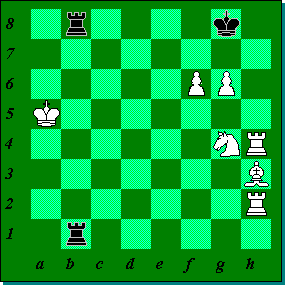 Seeing her husband in despair and on the point of resignation, she cried out: "O Prince, sacrifice your two rooks, and save Dilaram; forward with your elephant and pawn, and with the horse give checkmate" (translation after N Bland, Persian Chess, 1850). So guided the Prince saw the solution, and won the game. The position is provided here, using modern pieces. The elephant is represented by the bishop. Remember that the elephant moves two squares along any diagonal, jumping any intervening piece. The solution is provided at the bottom of this section.
Seeing her husband in despair and on the point of resignation, she cried out: "O Prince, sacrifice your two rooks, and save Dilaram; forward with your elephant and pawn, and with the horse give checkmate" (translation after N Bland, Persian Chess, 1850). So guided the Prince saw the solution, and won the game. The position is provided here, using modern pieces. The elephant is represented by the bishop. Remember that the elephant moves two squares along any diagonal, jumping any intervening piece. The solution is provided at the bottom of this section.
Shatranj spread from Persia through Arabia and to Byzantium. How and when it entered Europe is not known. Three possible routes include Moorish Spain in the 7th century, through Byzantium at about the same time, and via the Crusades in the 12th century. The moves changed little in the ensuing centuries, and a text on the game of chess written in 1474 described a game essentialy identical to Shatranj.
The rules of the game, the setup, and the moves of the pieces resemble those of modern chess, but without the scope granted to the equivalent of the bishop (elephant) and queen (prime minister). Also, the initial positions of the king and prime minister were opposite those of the king and queen in modern chess. The moves of the pieces are given in the table below, with the Arabic names for the pieces.
| Name | Translation | # of Pieces | Move |
|---|---|---|---|
| Shah | King | 1 | One square in any direction |
| Firz | Prime Minister | 1 | One square diagonally |
| Fil | Elephant | 2 | Two squares diagonally; may leap intervening pieces |
| Faras | War Horse | 2 | One square orthagonally, then one square diagonally; may leap intervening pieces |
| Rukh | Hero | 2 | Orthagonally, any number of unobstructed squares |
| Baidaq | Pawn | 8 | One square forward; captures one square diagonally forward; on reaching the back rank it is promoted to a Firz. |
The game could be won in three ways:
- Checkmate: when the opponent's king is unable to avoid capture on the next move.
- Isolation: when all of the opponent's pieces, except for the king, have been captured.
- Stalemate: If the opponent has no legal moves, he is allowed to switch the position of his king with any other of his pieces that remain on the board, provided that the exchange does not place the king in check. The exchanged piece is known as the "victim", as it is usually captured. If the opponent has no legal moves or exchanges, he is lost.
Dilaram's Solution: It is white's move; he is in danger of being mated by the movement of the rook at b8 to a8, so he must force black to make other moves. The rook at h4 moves to h8, giving check. The king is forced to capture the rook, whereupon the elephant at h3 moves to f5, exposing the black king to check from the rook at h2. The king moves back to g8. The rook at h2 moves to h8, placing the king in check, and again forcing the king to capture. White then plays the pawn at g6 to g7, giving check; once again, the king must move back to g8. White now plays the horse to h6, giving checkmate.
The "Great Chess", or "Tamerlane's Chess" was the variation played by the Mogul conquerer. The game board held 112 squares, and featured 28 pieces on each side. This form of chess had been lost for several hundred years, until it was rediscovered in a Persian manuscript.
 Byzantine Chess, or Circular Chess, was an odd variant played on a circular board having 64 squares and 4 citadels. The moves were similar to those of Shatranj, except that there was no pawn promotion. If two of a player's pawns circled the board and came face-to-face, the player's adversary lifted both pawns from the board before making his own move. If a player's king sought refuge in his opponent's citadel, the game was drawn.
Byzantine Chess, or Circular Chess, was an odd variant played on a circular board having 64 squares and 4 citadels. The moves were similar to those of Shatranj, except that there was no pawn promotion. If two of a player's pawns circled the board and came face-to-face, the player's adversary lifted both pawns from the board before making his own move. If a player's king sought refuge in his opponent's citadel, the game was drawn.
Courier Chess was played in Germany at the beginning of the 13th century, and for several centuries thereafter. A painting by Van Leyden, produced circa 1520, portrays a game of courier chess. The village of Ströbeck was presented a board by Elector-Prince Frederick William of Brandenburg in 1651, which the village still possesses. The board measures 12 by 8 squares, and features the addition of three pieces: the sage, the jester, and the courier.
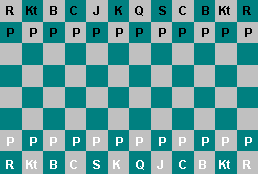 The Courier Chess Board
The Courier Chess Board
| Symbol | Name | # of Pieces | Move |
|---|---|---|---|
| K | King | 1 | one square in any direction |
| Q | Queen | 1 | one square diagonally; on 1st move can "joy leap" vertically forward to the 3rd rank |
| B | Bishop | 2 | two squares diagonally; can leap intervening pieces |
| Kt | Knight | 2 | knight's move in modern chess |
| R | Rook | 2 | rook's move in modern chess |
| C | Courier | 2 | bishop's move in modern chess |
| J | Jester | 1 | one square orthagonally |
| S | Sage | 1 | one square in any direction |
| P | Pawn | 12 | modern pawn's move, except the rook & queen pawns can move 2 squares on the first move |
A game of courier chess frequently began with both players moving their rook and queen pawns to the fourth rank, and leaping the queen to the third rank, in order to speed the game.
On reaching the 8th rank a pawn was not automatically promoted. The pawn must leap backward to the 6th, 4th, and 2nd ranks, whereupon it was promoted to a queen. The pawn could make no captures nor any other moves during these leaps, and could not leap over intervening pieces. These leaps did not have to be made on consecutive moves. While on the 8th rank, the pawn was immune to capture.
From India chess also spread into the orient. One of the general features of chess in the far east is that draws by perpetual check are usually not allowed; the player forcing the checks is judged to have lost the game.
Chess in Burma, called Sittuyin, is unusual in that the initial arrangement of the major pieces on the board are the opening moves of the game. Each player places his soldiers (pawns) in predesignated positions, four on the third rank, and four on the fourth. Then each player in turn places one major piece anywhere on his own side of the board, until all of the pieces are on the board. Players may continue to shift their pieces on their own side of the board until a soldier is moved, at which point normal play begins. One interesting feature of the game is that a player is not allowed to place an opponent in a stalemated position (i.e. a position in which the opponent has no legal moves).
Siamese chess (Mak-ruk) uses cowrie shells for the pawns, which are lined up on each player's third rank at the start of the game. A pawn that reaches the opponent's third rank is promoted; this status is indicated by turning the cowrie over. An interesting feature of this game is that a player who has isolated the opponent's king must achieve checkmate within a fixed number of moves, determined by calculating the strength of the player's remaining forces. Failure to do this means the game is drawn.
The versions of chess played in China and Japan have drifted quite a distance from their Indian origins, and are described below in their own sections.
Siang K'i (Xiàngqí) adds a number of interesting features to the game, including fortresses, a moat, and cannons. As usual, a legendary antiquity is claimed for the game; however, its earliest mention is found in the Book of Marvels (Xuanguai Lu), attributed to Nui Seng-ju, who died in AD 847. The game is popular in China, and especially in Hong Kong.
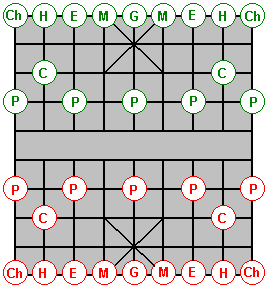 The game board is split into two territories, each measuring 5 by 9 grid lines, separated by a "moat". The pieces are not played within the squares, but at the intersections of the grid lines. Each player has a "fortress" composed of 4 squares marked with diagonal slashes at each end of the board. The playing pieces are discs with their ranks written on their upper faces in ideograms. One side is marked in red, the other in green or black. Some of the characters for pieces having the same powers differ from one side to the other. The moves of the pieces are:
The game board is split into two territories, each measuring 5 by 9 grid lines, separated by a "moat". The pieces are not played within the squares, but at the intersections of the grid lines. Each player has a "fortress" composed of 4 squares marked with diagonal slashes at each end of the board. The playing pieces are discs with their ranks written on their upper faces in ideograms. One side is marked in red, the other in green or black. Some of the characters for pieces having the same powers differ from one side to the other. The moves of the pieces are:
| Symbol | Name | # of Pieces | Move |
|---|---|---|---|
| G | General | 1 | one point orthagonally; may not leave the fortress |
| M | Mandarin | 2 | one point diagonally; may not leave the fortress |
| E | Elephant | 2 | two points diagonally; may not leap intervening pieces; may not cross the moat |
| H | Horseman | 2 | one point orthagonally followed by one point diagonally; may not leap intervening pieces |
| Ch | Chariot | 2 | rook's move in modern chess |
| C | Cannon | 2 | like the Chariot, but only captures if it jumps an intervening piece (called the "screen") from either side; may only jump a piece when making a capture, and may not jump more than one piece in a turn. |
| P | Pawn | 5 | one point forward on its own side of the board; in enemy territory it may move sideways and forward; there is no promotion - a pawn on the last rank may only move sideways |
The object is to checkmate the general, and all of the usual rules of western chess apply. There are some variations worth mentioning regarding checks. When generals face each other along an unobstructed file, one of the generals is in check. Since a general may not move into check, this only occurs when the two generals are on the same file, and a player moves the sole intervening piece. The player moving the piece that exposes the generals on the file gives the check. As the horseman cannot jump an intervening piece, a check given by the horseman can be blocked by interposing a piece on the angle of the horseman's move. Finally, a cannon attacks the general in the same way as it attacks any other piece - by "shooting" over a "screen". If the screen is removed, or if another piece is interposed, the check is relieved. If the check cannot be relieved, the general is lost and the game is over.
Variants of shogi have been played in Japan for centuries; the game is almost as ancient as siang k'i. Shogi as it is played today was invented in the late 16th century, purportedly by the Emperor Go-Nara. It is immensely popular in Japan, having more than ten million players. In medieval Japan there were seven ranks, the seventh being the highest. The highest rank was not always awarded, and was often vacant. In those times there were a number of families who were particularly associated with the game, and whose membership traditionally included many of the highest ranked players.
Currently, players are ranked as amateurs or professionals by the All Japan Shogi Association. Becoming a shogi professional is a difficult feat. Amateurs start at 15th kyu and work their way toward 1st kyu; some amateurs manage to achieve dan rankings. Professional players start at 1st dan and make their way up through higher ranks; the highest is 9th dan, usually held by no more than 2 or 3 players at any one time. An annual match, called the Meijin-sen, is held between the previous year's champion and the leading contender, the winner bearing the title of "Meijin" for the ensuing year.
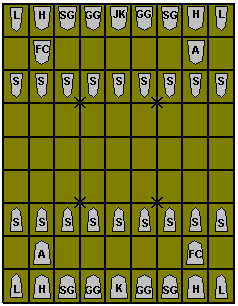 Shogi brings to chess an interesting level of complexity. The board is laid out in a 9 by 9 grid. The pieces are wedge-shaped tablets resembling small obelisks, that lie flat on the board. As in siang k'i, the names of the pieces are inscribed on the pieces. Each piece, save the Kings and the Gold Generals, has a specific value to which it can be promoted during the game, the symbol for which is inscribed on the reverse side of the piece (the first move is determined by furigoma, or "pawn toss"; the superior player tosses 5 pawns; if most of the pawns land with the unpromoted side face-up, the tosser gets the first move; the winner of a game begins the next). Promotion occurs when a player's piece enters enemy territory, defined as the three ranks closest to the opponent's side of the board. Promotion is at the player's option for each turn the piece begins or ends a move in enemy territory, except when a soldier or lance reaches the last rank, or the horse reaches one of the last two ranks, when promotion is automatic. The moves of the pieces, and their promotion values are given in the following table:
Shogi brings to chess an interesting level of complexity. The board is laid out in a 9 by 9 grid. The pieces are wedge-shaped tablets resembling small obelisks, that lie flat on the board. As in siang k'i, the names of the pieces are inscribed on the pieces. Each piece, save the Kings and the Gold Generals, has a specific value to which it can be promoted during the game, the symbol for which is inscribed on the reverse side of the piece (the first move is determined by furigoma, or "pawn toss"; the superior player tosses 5 pawns; if most of the pawns land with the unpromoted side face-up, the tosser gets the first move; the winner of a game begins the next). Promotion occurs when a player's piece enters enemy territory, defined as the three ranks closest to the opponent's side of the board. Promotion is at the player's option for each turn the piece begins or ends a move in enemy territory, except when a soldier or lance reaches the last rank, or the horse reaches one of the last two ranks, when promotion is automatic. The moves of the pieces, and their promotion values are given in the following table:
| Symbol | Name | # of Pieces | Promotion to: | Move |
|---|---|---|---|---|
| K/JK | King/Jewelled King | 1 | --- | one square in any direction |
| GG | Gold General | 2 | --- | one square orthagonally, or diagonally forward |
| SG | Silver General | 2 | GG | one square diagonally, or straight forward |
| H | Honourable Horse | 2 | GG | two squares straight forward, then one square right or left; may leap intervening pieces |
| L | Lance | 2 | GG | any number of open squares, straight forward only |
| A | Angle-going | 1 | DH* | bishop's move of modern international chess |
| FC | Flying Chariot | 1 | DK* | rook's move of modern international chess |
| S | Soldier | 9 | GG | one square straight forward (does not capture on diagonals) |
The pieces are not colored, and are distinguished only by the direction in which they point. This enables the use of a unique rule - captured pieces may be returned to the board on the side of the player who captured the piece, simply by turning the piece to point toward the opponent and dropping it on any vacant square. This may be done on any turn the player desires, so that the drop can be made to maximum effect.
The drop of a piece is subject to the following rules:
- Only one piece may be dropped in a turn, and the drop counts as the player's move for that turn.
- Pieces that have been promoted revert to their original powers when dropped onto the board, even if dropped into enemy territory. In the latter case, they may be promoted again once they have made a move.
- A soldier cannot be dropped on a file occupied by one of the player's unpromoted soldiers.
- A soldier or lance cannot be entered on the last rank, or the honourable horse on the last two ranks; otherwise, they could never move and so never promote.
- A soldier may be dropped so as to give check, but not to give checkmate.
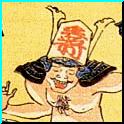 Parodies of Shogi
Parodies of Shogi
 I end this survey of chess in history with a few brief points concerning international chess as it is known today. Chess reached its present form in the 15th and 16th centuries, when the queen was endowed with her sweeping powers, and when castling was introduced to the game.
I end this survey of chess in history with a few brief points concerning international chess as it is known today. Chess reached its present form in the 15th and 16th centuries, when the queen was endowed with her sweeping powers, and when castling was introduced to the game.
Beginning in the 19th century, positional theory came to the fore. Steinitz demonstrated the value of a methodical approach to development and the use of small advantages (such as two bishops against a bishop and knight) that is taken for granted today. In the 20th century, Nimzovitch developed an integrated system for playing chess, that has become a standard for the game. My System, first published in 1930, is still regarded by many as the essential text for the serious student of chess.
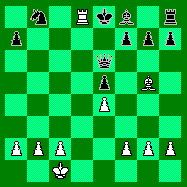 Morphy's Opera Box Game - An Animated Show...
Morphy's Opera Box Game - An Animated Show...
...wherein the legendary master from New Orleans demonstrates that two heads are lesser than one!
A knowledge of chess history is certainly not essential to playing the game well, as Deep Blue and other chess programs have shown. It does make for a fascinating story however, as I hope this brief sketch has shown.
The internet has created a new venue for chess players. Previously, to play a game with players at any distance involved mailing moves back and forth, entailing a wait of days or weeks for a reply. Moreover, the winner was usually the player with the best chess library and, more recently, with the best chess computer program. Use of e-mail has speeded things up considerably, although book research and number crunching are still realities that have to be faced.
Live games can now be played with chess players anywhere in the world. Currently the best way of doing this is via Telnet. Through Telnet, a number of players all log into a single remote chess server. Using their computers as remote terminals, the moves are transmitted to the server, and from the server to the other player.
The servers provide rough schematics of the chess boards using ASCII text characters, but most players prefer to use specialized "client software" that interprets the data stream from the remote computer and displays the position on a graphic interface. The software also allows the chess player to make moves using a mouse, rather than having to enter the moves from the keyboard. This client software can be downloaded free of charge from any number of FTP sites or web pages. You can play directly from many servers' web pages by using a Java "applet", though in my experience applets tend to be slower and less versatile than the available client software.
A time-keeping program is usually integrated into the client software, so that timed games can be played. This allows time control methods that have not been available to over-the-board players with standard chess clocks. One popular time control is "2 12", meaning each player has 2 minutes to make all of his or her moves, but every move adds 12 seconds to the player's clock. This allows faster games than the standard "40 moves in two hours" or "30 moves in 30 minutes" time controls, but also allows a game much more relaxed than the 5 minute blitz game. Note however that just about any time control, including 1 minute lightning games, can be played.
The largest chess server in the world is the Internet Chess Club. Their home page provides instructions on how to obtain client software, and how to log onto their server. They charge for their service, although they allow limited access to "guests" free of charge.
An internet server that is completely free is appropriately named FICS: the Free Internet Chess Server. You can log onto this server by invoking a telnet session using client software, or using FICS's Java application. Client software for FICS can be obtained from the FICS web page.
Another page on the history of chess can be found at the Chess - Online Guide. This is part of an overall site on traditional games, and contains a lot of interesting information. For information on modern international chess and other chess links, I recommend you to The Chess Cafe.
Tim Eagen
August, 1997
Page updated: 12/30/2014
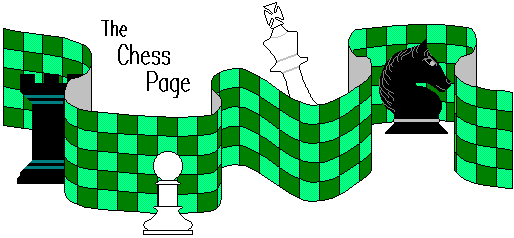

![[Contents]](../../utility/duarrow.gif)